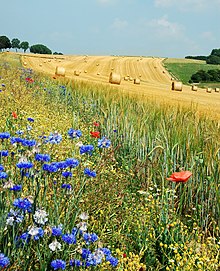Field margins
A field margins is a marginal area of fields , determined without the use of herbicides and pesticides is managed so that there arable wild herbs spread and adapted to them wildlife and survive. In contrast to flower strips , which are sown in spring with a flowering mixture, the aim of the field margin strips is to promote the field wild herbs ( Segetal plants ) native to the site . Due to its marginality, it can be counted among the fringing biotopes .
Larger areas that are cultivated according to this concept are referred to as protective fields .
Individual federal states, co-financed by the European Union , promote the creation of these areas in the so-called field margins program by making compensatory payments to the participating farmers. Particularly in the 1980s, strips of field margins, based on the initiative of W. Schumacher in North Rhine-Westphalia, were a protection concept that was widespread almost nationwide, but is currently on the decline due to the bureaucratic effort. Although there are very strong indications that the progressive increase in yields in the European agricultural landscape is also causing the number of endangered arable weeds to continue to rise.
Strip margins not only promote biodiversity . Natural antagonists of pests can also develop there, as a study on Swiss wheat fields showed. Pests of the species Oulema gallaeciana ( leaf beetles ) have been biologically reduced. In the study led by Matthias Tschumi , an up to 10% higher yield on organically farmed areas was observed in the edge area of the strips , but without going into the economic profitability for the entire area.
See also
Web links
- Schutzaecker.de
- Research station Agroscope Reckenholz-Tänikon ART Habitat for arable shrub strips: the underestimated ecological area. (PDF)
- Karlstadter position paper on the protection of wild herbs.
Individual evidence
- ↑ W. Schumacher: Protection and conservation of endangered wild herbs through integration of agricultural use and nature conservation. In: Nature and Landscape . Volume 55, No. 12, Bonn 1980, pp. 447-453
- ↑ J. Storkey, S. Meyer, KS Still, C. Leuschner: The impact of agricultural intensification and land-use change on the European arable flora In: Proceedings of the Royal Society B. Volume 279, 2012, pp. 1421-1429
-
↑ M. Tschumi, M. Albrecht, C. Bärtschi, J. Collatz, MH Entling, K. Jacot: Wildflower strips enhance biological pest control and yield. In: Society for Ecology e. V. (Hrsg.): Negotiations of the society for ecology. Volume 45th Annual Meeting of the Society for Ecology. Görich & Weiershäuser, Marburg 2015, p. 163
Wild plants increase yield in neighboring fields. On: idw-online.de from September 2, 2015
